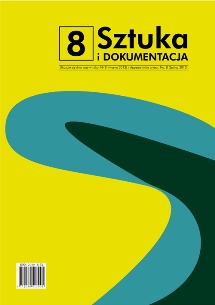Muzeum Józefa Szajny i synteza sztuk: dokumentacja kontekstu wielomedialnego dzieła sztuki – ochroną jego idei
The Museum of Józef Szajna and Synthesis of the Arts: Documentation Relating to the Context of Multi-media Works of Art – the Protection of His Ideas
Author(s): Natalia AndrzejewskaSubject(s): Fine Arts / Performing Arts
Published by: Akademia Sztuk Pięknych w Gdańsku
Keywords: Józef Szajna; konserwacja; dzieło efemeryczne; sztuka efemeryczna; dokumentacja; synteza sztuk; gesamtkunstwerk; galeria studio
Summary/Abstract: The aim of this text is to demonstrate the preservation of a complex work of modern art, through the documentation of its context. The case study concerns the environment Replika created by Józef Szajna in 1971. The work of Szajna is an example of Total Art. The concept of his environment involves the combination of the material artwork and its message (including the use of readymades), the creation of a theatrical space with the use of lighting and a special atmosphere. The entire combination of the work is necessary in case of its re-exhibition. Conservation through documentation is a solution to the problem of maintaining the authenticity of a work of art which displays features of a Gesamtkunstwerk. In the past museums or galleries were collections of material objects, while today they are collections of works of art distant from the traditional “fine arts” disciplines: hybrid, comprehensive works of art, including those partially or entirely ephemeral. This problem is followed by the issue of the presentation of works of art in a way which includes the ideological and social context and the Artist’s creative individuality. A lot has been achieved throughout the last decade as far as the issue of documentation of works of art integrating various media is concerned. The issue, however, is still a challenge for a conservator-curator. The documentation procedures are facilitated thanks to the creation of various initiatives’ networks and further development of models, standards and tools as well as by the organisation of training sessions. The documentation forms that include various strategies for the protection of interdisciplinary and ephemeral works of art (reconstruction, re-enactment, emulation and reinterpretation) gradually enter the repertoire of methods used to protect world cultural heritage. The language of Szajna’s art gives full expression to this artist’s total creative personality. The moment when a work of art that integrates various media is displayed again is a key test for the effectiveness of its protection strategies. This problem is followed by the issue of the presentation of an artwork in a way which includes the ideological and social context and the artist’s creative individuality. The documentation programs developed by scientists, conservators and artists show the ways to display works of a complex nature, connected with a given space and which aim to engage the viewer. Therefore is it important that the complex and multi-componential works are each time re-installed in accordance with the original intention of the author which is expressed in the documentation. In my work as conservator and curator I wish to show the necessity of treating the work and the means of preserving its integrity in an homogeneous manner.
Journal: Sztuka i Dokumentacja
- Issue Year: 2013
- Issue No: 8
- Page Range: 21-26
- Page Count: 6
- Language: Polish

